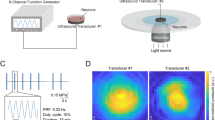Abstract
Objective
Phasic myometrial contractions appear to be produced by calcium transients resulting from the activation of the phosphatidylinositol-signaling pathway. Bay K 8644, an L-type calcium channel activator, produces an increase in frequency and intensity of phasic myometrial contractions. These studies were performed to test the hypothesis that Bay K 8644—stimulated contractions were mediated through mechanisms involving phosphoinositide-specific phospholipase C activation and cytosolic calcium oscillation-like mechanisms.
Methods
In vitro contraction studies and intracellular calcium imaging were performed on longitudinal strips of uterine tissue obtained from mature virgin Sprague-Dawley rats. Isometric contraction data were computer digitized, analyzed for contraction area, and normalized for cross-sectional area. Dose-response studies were performed using previously reported inhibitors of cytosolic calcium oscillation mechanisms. In addition, qualitative inositol-phosphate production studies were performed after prelabeling uterine tissue in vitro with 3H-inositol. Subsequently, the labeled inositol phosphates were separated and recovered using anion exchange chromatography.
Results
Bay K 8644 produced periodic calcium transients or oscillations along with a dose-related increase in contractile activity and a significant increase in inositol-phosphate production. In contrast, neomycin (an inhibitor of phospholipase C), adenine (an inhibitor of calcium-induced calcium release), nifedipine (an L-type calcium channel blocker), and EGTA (a calcium chelator) significantly inhibited Bay K 8644-stimulated contractile activity.
Conclusions
These results are consistent with the hypothesis that Bay K 8644, through its facilitation of increased intracellular calcium, results in the activation of the phosphatidylinsitol-signaling pathway and cytosolic calcium oscillation-like phenomena, thereby resulting in the generation of phasic myometrial contractions.
Similar content being viewed by others
References
Schrey M, Cornford P, Read A, Steer P. A role for phospho-inositide hydrolysis in human uterine smooth muscle during parturition. Am J Obstet Gynecol 1988;159:964–70.
Phillippe M. Mechanisms underlying phasic contractions of pregnant rat myometrium stimulated with aluminum fluoride. Am J Obstet Gynecol 1994;170:981–90.
Phillippe M. The relationship between oxytocin, phosphoinositide-specific phospholipase C, and phasic myometnal contractions. J Soc Gynecol Invest 1994;1:49–54.
Sato K, Ozaki H, Karaki H. Changes in cytosolic calcium level in vascular smooth muscle strip measured simultaneously with contraction using fluorescent calcium indicator Fura 2. J Pharmacol Exp Ther 1988;246:294–300.
Berridge M. Cytoplasmic calcium oscillations: A two pool model. Cell Calcium 1991;12:63–72.
Berridge M, Galione A. Cytosolic calcium oscillators. FASEB 1988:2:3074–82.
Kanmura Y, Missiaen L, Casteels R. Properties of intracellular calcium stores in pregnant rat myometrium. Br J Pharmacol 1988;95:284–90.
Poll E, Merialda A, Coruzzi G. Characterization of the spontaneous motor activity of the isolated human pregnant myometrium. Pharmacol Res 1990;22:115–24.
Knot H, de Ree M, Gahwiler B, Ruegg U. Modulation of electrical activity and of intracellular calcium oscillations of smooth muscle cells by calcium antagonists, agonists, and vasopressin. J Cardiovasc Pharmacol 1991;18(supplement 10):S7–14.
Kyozuka M, Crankshaw J, Daniel E. Calcium channels in isolated cells and strips of longitudinal muscle of rat myometrium. Can J Physiol Pharmacol 1986;65:1975–81.
Godfraind T. Calcium channels in smooth muscle. Ann NY Acad Sci 1988;522:312–27.
Bechem M, Schramm M. Calcium agonists. J Mol Cell Cardiol 1987;19(supplement 11):63–75.
Zwieten PA, Timmermans P. Receptor subtypes involved in the action of calcium entry blockers. Ann NY Acad Sci 1988;522:351–60.
Harootunian A, Kao J, Paranjape S, Tsien R. Generation of calcium oscillations in fibroblasts by positive feedback between calcium and IP, Science 1991;251:75–8.
Molnar M, Hertelendy F. Regulation of intracellular free calcium in human myometnal cells by prostaglandin F2α: Comparison with oxytocin. J Clin Endocrinol Metab 1990;71:1243–50.
Phillippe M, Bangalore S. Adrenergic stimulation of inositolphosphate production in a genital tract smooth muscle cell line. Biol Reprod 1989;40:49–53.
Phillippe M, Chien E, Freij M, Saunders T. Ionomycin stimulated phasic myometrial contractions. Am J Physiol 1995;269: E779–85.
Phillippe M, Chien EK. Potassium chloride effects on the hormonal signal transduction mechanisms underlying phasic myometrial contractions. J Endocrinol 1995;146:485–93.
Phillippe M. Protein kinase C, an inhibitor of oxytocin-stimulated phasic myometrial contractions. Biol Reprod 1994;50:855–9.
Burgess G, McKinney J, Irvine R, Putney J. Inositol 1,4,5-trisphosphate and inositol 1,3,4-trisphosphate formation in Ca2+-mobilizing-hormone-activated cells. Biochem J 1985;232:237–43.
Kondo K, Kozawa O, Takatsuki K, Olso Y. Ca2+ influx stimulated by vasopressin is mediated by phosphomositide hydrolysis in rat smooth muscle cells. Biochem Biophys Res Comm 1989;161:677–82.
Hazama A, Okada Y. Involvement of Ca2+-induced Ca2+ release in the volume regulation of human epithelial cells exposed to a hypotonic medium. Biochem Biophys Res Comm 1990,167: 287–93.
Harootunian A, Kao J, Paranjape S, Adams S, Potter B, Tsien R. Cytosolic Ca2+ oscillations in REF52 fibroblasts: Ca2+ -stimulated IP3 production or voltage-dependent Ca2+ channels as key positive feedback elements. Cell Calcium 1991;12:153–64.
Do Khac L, Mokhtari A, Rentier M, Harbon S. Activation of adrenergic receptors inhibits Ca2+ entry mediated generation of inositol phosphates in the guinea pig myometrium, a cyclic AMP-independent event. Mol Pharmacol 1991;41:509–19.
Enjalbert A. et al. Dual mechanisms of inhibition by dopamine of basal and thyrotropin-releasmg hormone-stimulated inositol phosphate production in anterior pituitary cells. J Biol Chem 1990:265:18816–22.
Akhtar RA, Abdel-Latif AA. Requirement for calcium ions in acetylcholine-stimulated phosphodiesteratic cleavage of phos-photidylmyo-inositol 4,5-bisphosphate in rabbit iris smooth muscle. Biochem J 1980;192:783–91.
Brown AM, Yatani A, Imoto Y, Codina J, Mattera, Birnbaumer L. Direct G-protein regulation of Ca2+ channels. Ann NY Acad Sci 1989;560:373–86.
Nebigil C, Malik K. Alpha adrenergic receptor subtypes involved in prostaglandin synthesis are coupled to Ca2+ channels through a pertussis toxin-sensitive guanine nucleotide-binding protein. J Pharmacol Exp Ther 1993;266:1113–24.
Vites A, Pappano A. Distinct modes of inhibition by ruthenium red and ryanodine of calcium-induced calcium release in avian atrium. J Pharmacol Exp Ther 1994;268:1476–84.
Klein M, Simon B, Schneider M. Effects of procaine and caffeine on calcium release from the sarcoplasmic reticulum in frog skeletal muscle. J Physiol 1992;453:341–66.
Author information
Authors and Affiliations
Additional information
This research was funded by the National Institute of Child Health and Human Development (HD22063).
Rights and permissions
About this article
Cite this article
Chien, E.K., Saunders, T. & Phillippe, M. The Mechanisms Underlying Bay K 8644-Stimulated Phasic Myometrial Contractions. Reprod. Sci. 3, 106–112 (1996). https://doi.org/10.1016/1071-5576(96)00006-8
Published:
Issue Date:
DOI: https://doi.org/10.1016/1071-5576(96)00006-8




